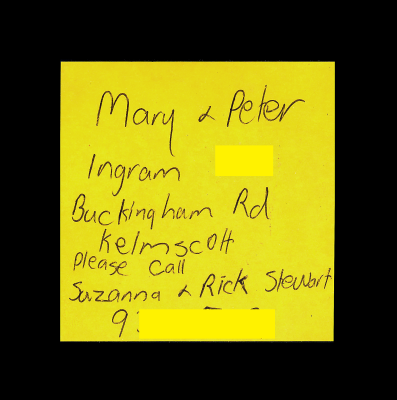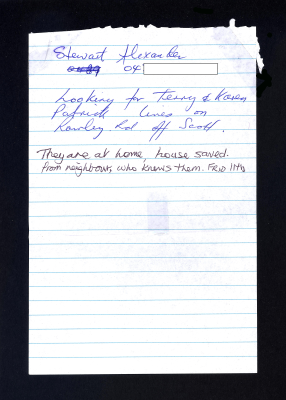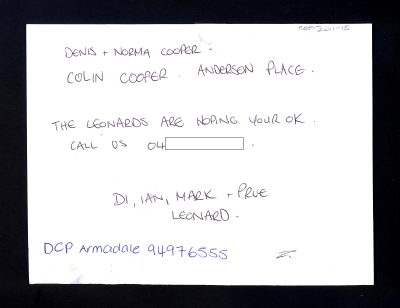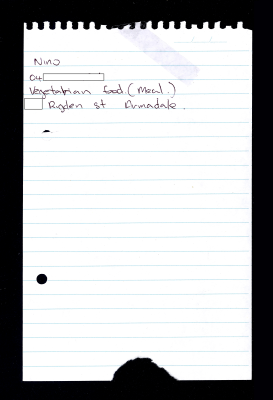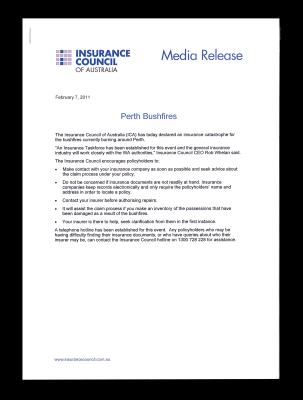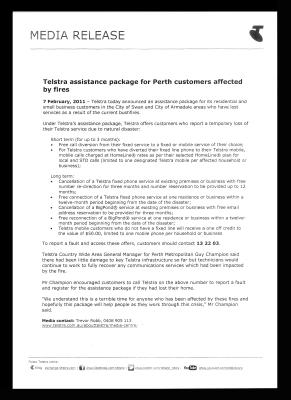16TH BATTALION AIF WWI CLOTH PATCH
1916 - 1919Cloth army patch of two coloured cloths sewn together. One half of the badge is dirty white in colour and the other is navy in colour. Probably sewn on to the arm of a soldier's uniform to denote his company. This patch belonged to 16th Battalion WWI
16th Battalion cloth badge belonged to Claude Marsh who served with the 16th when he fought in World War One. He was captured in France in 1917 and was a prisoner of war for the rest of the war. He worked as a labourer and farm hand in Germany.
Claude was born in Kelmscott on 3 August 1897. In 1916 Claude was working as a local farm hand when on 13 April he enlisted with the Australian Imperial Force. After his training he was part of the 21st reinforcement for the 16th Battalion and was sent to England.
On 8 Feb 1917 he proceeded overseas to France from Folkestone on the HMT Princess Victoria. Five days later he joined the 16th Battalion in Albury Camp near Bazentin, south east of Pozières. March 1917 was spent regrouping and training before a move back to the front lines occurred in early April with the intention of attacking the Hindenburg Line. Following several changes of plans, and failure of the tanks to arrive in time for an attack on 10 April, the attack on the OG1 and OG2 trenches between Bullecourt and Reincourt took place early on 11 Apr 1917. Despite a complete lack of artillery and tank support the Australians captured parts of their objectives, but were eventually forced back, taking very heavy losses. Over 1,000 were captured when they ran out of ammunition or were surrounded by the Germans, who in the absence of artillery, had moved up reinforcements.
Claude was one of those captured near Reincourt after his Company Commander was killed. The early days of captivity were bleak with the prisoners kept close to the front lines restoring roads and carrying out other works behind the German front line.
Interned at Limburg, Germany, he was later transferred to Friedrichsfeld and then Schneidemuhl in Prussia where he worked first on forestry work and then as a farmhand on a farm owned by a German Sergeant of Polish ethnicity. [1].
Claude was repatriated to England via Danzig on 18 Dec 1918 and departed for Australia board SS Khyber on 31 Mar 1919. He was discharged by the 5th Military District on 7 Aug 1919. See separate publication "A Guest of the Kaiser by Linton Reynolds" for the story of his time as a POW.
On his return to Western Australian he moved back to Armadale, worked as a labourer and was a very active member of the local community. Claude was involved with many community organisation including the Kelmscott Agricultural Society as well as being a member of and playing for the Armadale Football Club and the Armadale Cricket Club.
In 1936 he married Dorothy May Marsh, together they had two children.
During World War II Claude enlisted again, this time with the Volunteer Defence Corp. He spent 15 months with the VDC before being discharged in January 1942 to return to civilian essential services. Claude passed away in Armadale in 23 October 1976.
http://www.birtwistlewiki.com.au/index.php?title=Claude_Robert_Marsh
Details
Details
This object is part of collection with good provenance and interpretive potential that tells the story of the City of Armadale's connection to armed conflicts around the world from the late 1800s to today. The collection explores the experiences of people associated with the City of Armadale who went to war, their experiences when they returned as well as how these conflicts impacted the community who stayed behind.
City of Armadale - History House
City of Armadale - History House
Other items from City of Armadale - History House
- POST-IT-NOTE - FOR MARY & PETER INGRAM FROM SUZANNA & RICK STEWART
- NOTE HANDWRITTEN FROM STEWART ALEXANDER TO TERRY AND KAREN PATRICK
- NOTE HANDWRITTEN FROM THE LEONARDS TO DENIS, NORMA & COLIN COOPER
- NOTE HANDWRITTEN FROM NINO OFFERING VEGETARIAN MEAL
- INVITATION - BBQ FOR NEIGHBOURS AND PEOPLE WHOSE PREMISES ARE MEDIUM RARE & WELL DONE
- BUSINESS CARD - BANKWEST DISASTER RESPONSE TEAM
- MEDIA RELEASE - INSURANCE COUNCIL OF AUSTRALIA & OTHER INFORMATION
- MEDIA RELEASE - TELSTRA ASSISTANCE PACKAGE FOR PERTH CUSTOMERS AFFECTED BY FIRES
- NOTICE - DEPARTMENT OF HEALTH - USING RAINWATER AFTER A BUSHFIRE
- INFORMATION KIT - A GUIDE TO HELP YOU RECOVER FROM THE IMPACT OF A BUSHFIRE
- WATER BOTTLE - CITY OF ARMADALE
- CAN - SPC SPAGHETTI
